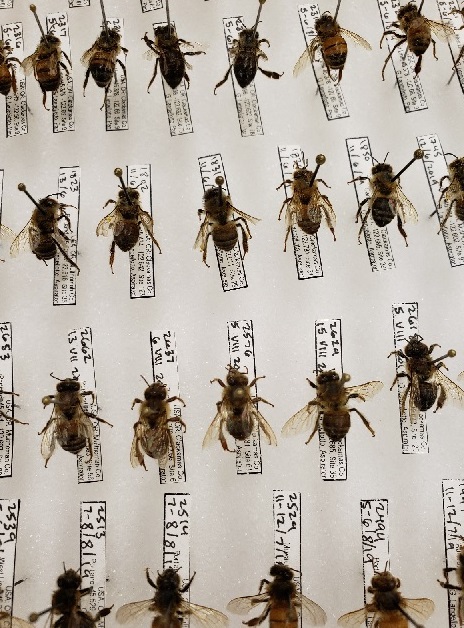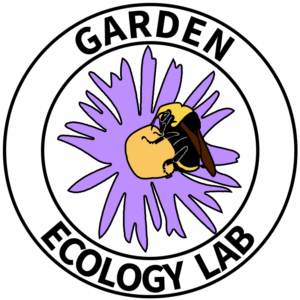Although I have been studying garden bees for the past three years, I was never focused on honey bees. From a biodiversity point of view, they are not very interesting to me. They are non-native and abundant. In fact, honey bees were the most abundant bee species that we collected in Portland-area gardens (332 individuals collected), even though we took great care not to collect more than one individual per visit, when hand-collecting.

Honey bees, which hail from Europe, are only one of 20,000 bee species, worldwide. In North America, there are 4,000 species of bee. In Oregon, we have between 400-500 species of bee. From Portland area gardens, we have documented 86 species of bee (with our 2019 bees still awaiting identification).
Unlike some native bees, honey bees are not at risk of extinction. Compare this to bumblebees. We found 17 species of bumblebee in Portland gardens, two of which (12%) are at risk of endangerment or extinction, due to declining populations: Bombus fervidus and Bombus caliginosus. Across North America, more than 25% of bumblebee species are thought to be at risk of extinction.

Frontal view of Bombus fervidus, a threatened bumblebee species that can be found in Portland area gardens. 
Dorsal view of Bombus fervidus, a threatened bumblebee species that can be found in Portland area gardens.
By focusing ‘save the bee’ campaigns on honey bees, we may be neglecting the bee species that really need our help. In fact, researchers have started to call out organizations and advertising campaigns that promote feel good stories about honey bee conservation as a form of ‘bee washing’. You can visit www.bee-washing.com to learn more about companies that promote their product or organization as being bee-friendly, in a less than genuine way.
Researchers have documented at least seven different ways that honey bees may harm native bee species (summarized in Cane and Tepedino, 2016):
- Honey bees monopolize and deplete nectar and pollen from local plant communities, which can reduce native bee reproduction.
- By depleting local plant resources, native bee females have to devote more time and energy to fly and find new resources, which also reduces native bee reproduction.
- Unlike honey bees, most bees are solitary, which means that they do not live in colonies and they do not have a queen. Solitary females who have access to fewer floral resources produce fewer daughters and more sons. Since female bees are needed to maintain a population, this skewed sex ratio can slow population growth and recovery in native bees.
- When females collect less nectar and pollen, they have less food to feed their young. These bees grow up to be smaller, and are more likely to die over winter, compared to well-fed bees.
- The longer a solitary bee mom is away from her nest, the higher risk that parasites and predators will attack her unguarded young.
- Honey bees can physically block native, solitary bees from preferred pollen hosts.
- Honey bees have many diseases. Some honey bee viruses have been found in native bee communities. Researchers think flowers that are visited by both native bees and honey bees are analogous to an elementary school water fountain: a place where repeat visitors can pick up a pathogen.
Please note that I am not suggesting that you extinguish honey bees from your garden. What I am asking, instead, is that you take the time to learn about and to notice some of the other 80+ species of bee that you might find in your garden. My group is creating a ‘Bees of Portland Gardens’ guide that we hope can help you in this journey. In the meantime, there are some great guides that are currently available. One is Wilson and Carrill’s ‘The Bees in Your Backyard: a guide to North America’s bees’. This book is available at Powell’s City of Books, as well as on Amazon. The second is August Jackson’s ‘The Bees of the Willamette Valley: a comprehensive guide to genera’. This free guide can be found online.
The first step to saving something you love is to be able to recognize it and to call it by name.
References
- Cane and Tepedino. 2016. Gauging the effect of honey bee pollen collection on native bee communities. Conservation Letters 10: 205-210.
- Jackson. 2019. The Bees of the Willamette Valley: A Comprehensive Guide to Genera. Self-Published, Online: https://tinyurl.com/y4qfssrl.
- Wilson and Carrill. 2016. Bees in Your Backyard: A Guide to North America’s Bees. Princeton University Press.




6 Comments
Add Yours →Thank you for articulating this so well, I will definitely use this article as a reference! When surveying for native bees in southern Oregon this last summer we had to visit 2-3 sites before we found natives and we were wondering why. Later we discovered about 30 hives approximately 5 miles from the site where we found the natives.
I am so glad for the lead sentence of your final paragraph!
Learning about native bees and other pollinators is super important though I’m sure there will soon be recognition that both Honey and native bees both need the same thing – a healthy environment for them to live with adequate food.
Many of the native bees have different tongue lengths than Honey bees and get nectar from different flower species; I have noticed that some of the native Bombus with similar length tongues (to Honey bees), forage on plants on different schedules; Bombus were on Hare’s Foot Clover (Trifolium arvense), for example, a good week before the Honey bees.
What I have found important is stocking levels of Honey bees. Most all areas (near me) can support several colonies of Honey bees without doing the native bees any harm. And in fact environmental changes made by homeowners in their effort to save the Honey bees also help native bees. It is when the stocking levels are out of balance that things like disease transfer become a concern.
– Master Gardener Volunteer (U Maine Cooperative Extension)
– Master Beekeeper (U Montana, E.A.S.)
– Executive Director, Maine Bee Wellness
Thank you. I think this is a real issue that the general public does not yet understand. Bee needs to be more inclusive.
Beekeepers are just that – they keep honey bees. But there are no keepers for the other 99% of bees. It’s natural that honeys would be dominant for that very reason, but in addition, people make money from honeys, so there’s that extra incentive for lots.
The answer to the dilemma is simple and totally doable. We need more forage and habitat for insects, birds, and other wildlife, or, in other words, we need more pollinator gardens, and landscapes filled with native plants. And much less pesticides.
And of course, more awareness and understanding of how the little bits of land that are left (not covered by houses, lawns, driveways, monocrops, roads, megastores, etc) can and must serve these tiny creatures on which our lives depend.
And, thanks so much for all the other great info coming out of your department, Gail.
As a beekeeper of nearly 50 years, I find it appalling that your research supposedly shows that honey bees are not at risk of Extinction. The only thing keeping the honey bee alive at this point in time are beekeepers. Due to pesticides, herbicides, GMOs, mono culture, diseases and viruses, and then add human greed for the almighty dollar, we now experienced a 60 to 80% loss of honeybees a year. Where it used to be 10 to 15% a year due to winter temperatures. If mono agriculture, as a whole, including pesticides and herbicides used in today’s farming, and the access to over-the-counter pesticides and herbicides are not better regulated or outlawed, WE WILL LOSE THE HONEY BEE!
Einstein once said, if the honey bee falls off the face of the Earth tomorrow, the human race we’ll have four to four and a half years of existence on the face of the earth.
Since Einstein’s time, the human race has more than doubled, so how much time would we have?
Thank you for keeping bees. I value and appreciate the hard work it takes to manage honey bee hives. Thank you, also, for commenting. I love healthy debate.
I suggest that honey bees are not at risk of extinction, because they are cared for as a domesticated animal. Cattle are not at risk of extinction, because they are cared for by farmers. Dogs are not at risk of extinction, because they are cared for by pet owners. Honey bees are not at risk of extinction, because they are cared for by bee keepers.
I agree that there are many threats to honey bee health, and am grateful that my colleagues at OSU study how to mitigate many of these stresses, including poor nutrition and exposure to pesticides. I am grateful that there are folks working to reduce pesticide use in agricultural crops and in beehives, and hope that this will reduce hive losses that beekeepers suffer, every year.
Nonetheless, no one has yet listed or applied to list the honey bee to the IUCN red list of threatened or endangered species. Surveys (including several of ours) show that the honey bee is one of the most abundant bees within bee communities. Honey bees face many problems, threats, and stresses ~ but I am not aware of data that suggests that they are approaching threatened, endangered, or extinct status.
https://www.snopes.com/fact-check/einstein-on-bees/